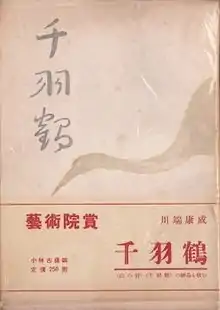Thousand Cranes
Thousand Cranes (千羽鶴, Senbadzuru) is a 1952 novel by Japanese author Yasunari Kawabata. The novel is divided into five episodes: "Thousand Cranes", "The Grove in the Evening Sun", "Figured Shino", "Her Mother's Lipstick" and "Double Star".
 First edition | |
| Author | Yasunari Kawabata |
|---|---|
| Original title | Senbadzuru (千羽鶴) |
| Country | Japan |
| Language | Japanese |
| Genre | Novel |
| Publisher | Kawabata Publishing |
Publication date | 1952 |
Published in English | 1958 |
| Media type | Print (paperback) |
Plot
The novel is set in Japan after World War II. The protagonist, Kikuji, who has been orphaned, becomes involved with Mrs. Ota, a former mistress of his father's. Chikako, another ex-mistress of his father, serves as the novel's antagonist. Chikako frequently imposes on Kikuji's life by trying to arrange an engagement between him and Yukiko, a beautiful girl who wears a kimono covered in cranes. Mrs. Ota commits suicide, seemingly because of the shame she associates with the affair, and after her death Kikuji transfers much of his love, and his grief over Mrs Ota's death, to her daughter, Fumiko.
Themes
Decay
The tea ceremony decays throughout the novel. It is no longer used for traditional Japanese purposes. Chikako has turned it into a tool for her to meddle with Kikuji's life. There are many instances of tea bowls being misused in the novel, with the novel's closing chapter describing Fumiko and Kikuji mutually destroying a precious piece of 17th century shino ware.
Legacy
Kikuji is unable to escape the life that his father left him, but he is also not willing to. He inherits all of his burdens and drama. Kikuji is a "modern" man as displayed by the fact he is a bachelor and conducts casual sexual relationships with modern women. Despite this Kikuji actively chooses to obsess over the past of his family. The reason for this is because in 1950s Japan was in a transient state between being connected and in tune with cultural practices of the past, whilst beginning to adopt westernised, modern cultural and social practices. This had massive effects on sexuality. As male sexuality, and therefore male identity, was supported by the subjugation of female sexuality, when economic and social modernity opened up new opportunities for women to have independence, women were no longer shackled to the household, and their approaches to sexuality changed. Thus, male sexuality and male identity which was superior on the basis of the subjugated, subservient female, was destabilised. Therefore, Kikuji's obsession with his father's sexuality is because he feels emasculated by strong females such as Mrs. Ota and Chikako, and so he is trying to establish a sense of agency which he aligns with his father, and the generation his father represents.
Kikuji chooses to inherit Mrs. Ota. He sees her as an object which is as transferable to him as his father's tea bowls, or his house, therefore he wishes he will also receive his father's dominant masculine identity. The first time he has sex with Mrs. Ota in the section Thousand Cranes, he states: "It was an extraordinary awakening."[1] This moment displays that Kikuji feels as if he has found a sense of self, and identity in this encounter, previously unexperienced by him before. He describes it as a "triumph", like "the conqueror whose feet were being washed by the slave."[2] Through this inheritance of his father's mistress, Kikuji believes he has regained his masculine identity and the power associated with it. He believes he has regained the dominant masculine sexuality of his forefathers he is entitled to, that his generation has lost.
Reception
This novel is one of three novels cited by the Nobel Committee in awarding Yasunari Kawabata the Nobel Prize for Literature. The other two books are Snow Country and The Old Capital. The novel was selected for translation and inclusion in the UNESCO Collection of Representative Works.
References
- Yasunari, Kawabata, Thousand Cranes, Translated by Edward G. Seidensticker. (London and USA: Penguin, 2011), p18.
- Kawabata, Thousand Cranes, p18.